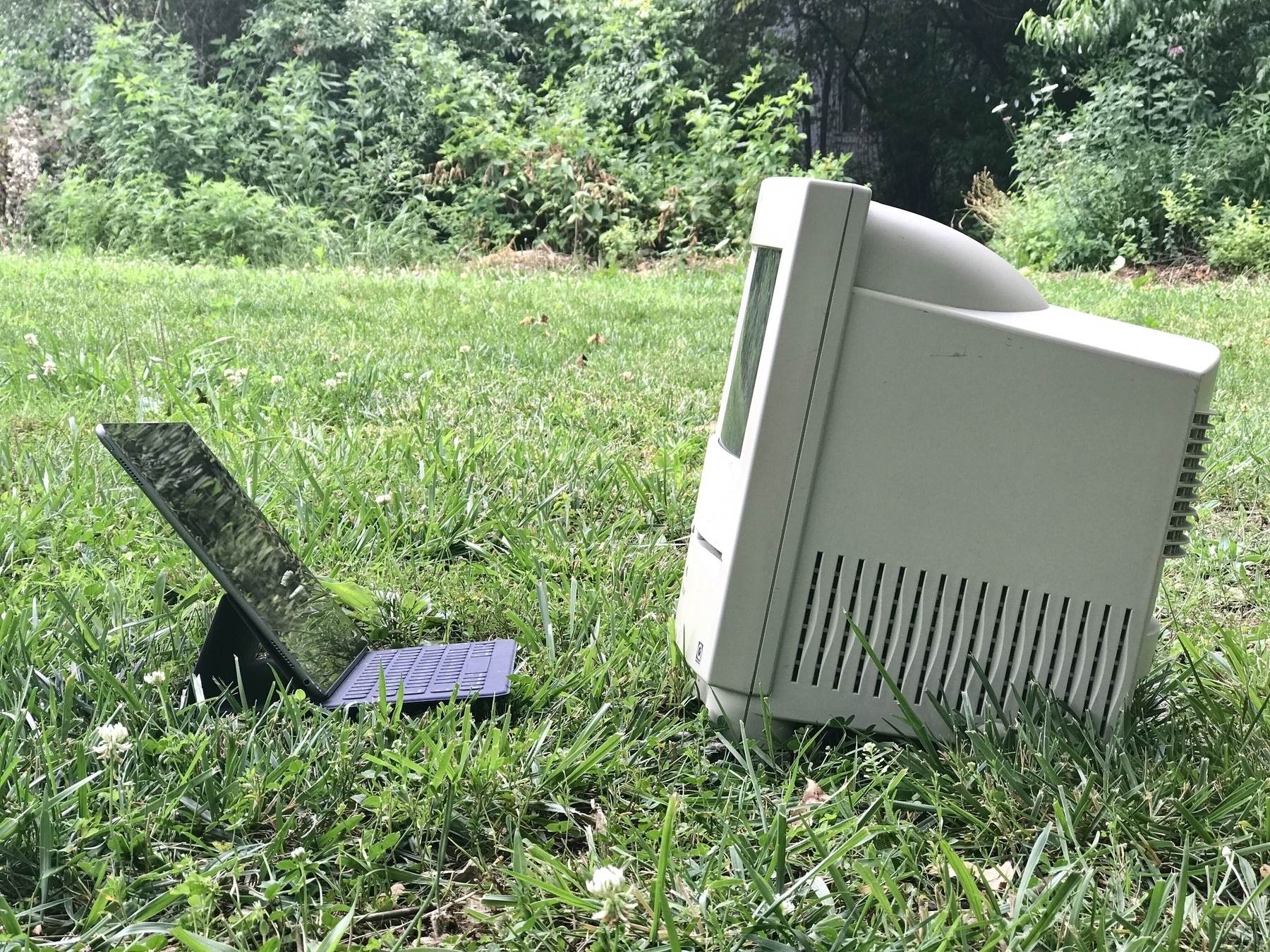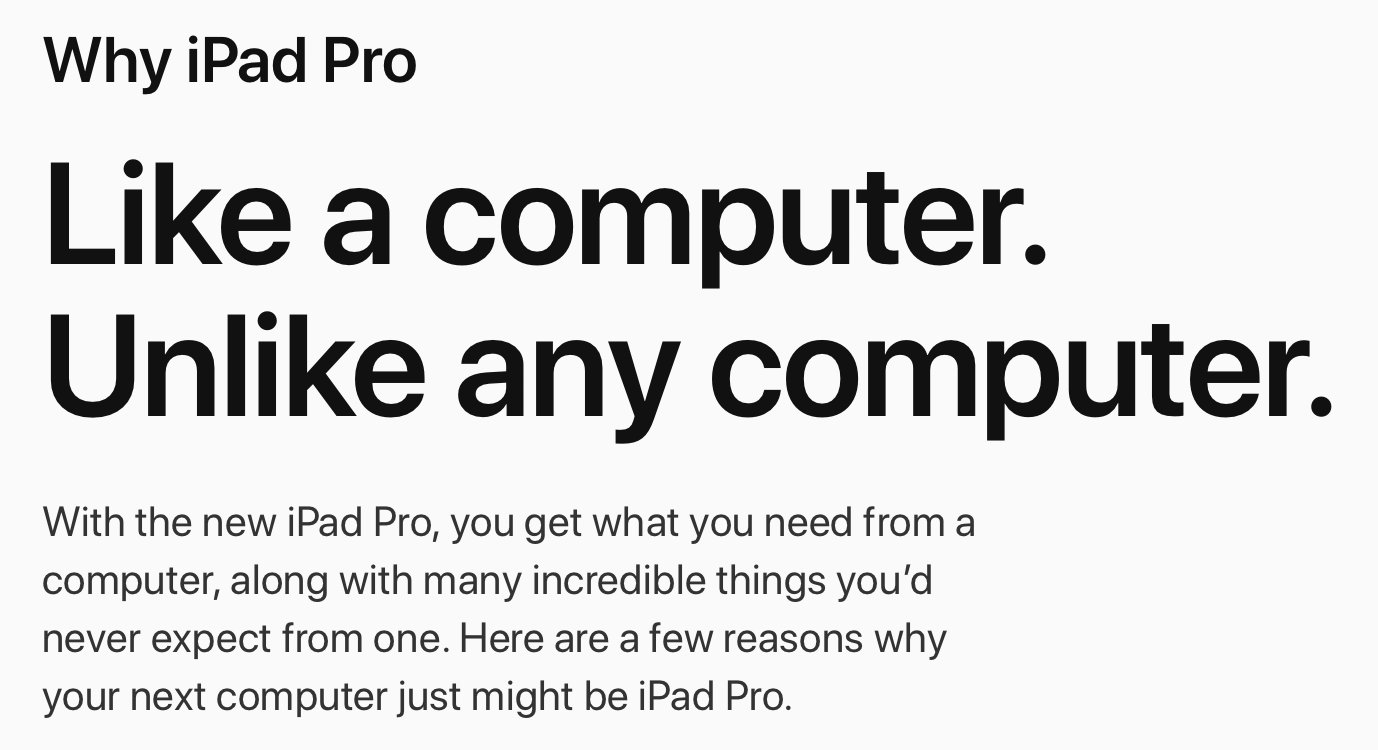The iPad has grown up from a mobile device to a mobile computer
[caption id=“attachment_462” align=“alignnone” width=“4032”] My Color Classic and iPad Pro as imaged by an iPhone 7+.[/caption]
My Color Classic and iPad Pro as imaged by an iPhone 7+.[/caption]
The beginning of Apple’s iPad story In 2010 Apple initially positioned the iPad as a middle device between the iPhone and a laptop. The message was that it was a friendly, easy to use device for email, web browsing, Facebook, games, videos. As Steve Jobs demonstrated on stage, it was a casual device meant to be used by anyone lounging about their home. Sure, Apple offered up the Keyboard Dock and Pages so it could also be used for word processing but that was secondary.
I can tell you that for many in my family it became their beloved (sometimes first and only) computer. But for them, mostly non-techies, it was, literally, just a bigger than iPhone screen. They knew it was a computer and yet it was not intimidating. It was a computer without seeming too much like a computer and given those characteristics it’s not surprising that it was especially popular with the very young and with elderly. At least, that was the case in my family. They’re all still happily using iPads though most have since updated at least once or twice.
This was Apple’s opening story for the iPad and it was a simple one: An easy to use computer that didn’t seem too computery that would be a great second purchase for its iPhone customers. It was obvious to everyone that the iPad was, in many ways, a larger iPhone and it ran a mobile operating system.
From Apple’s perspective this was all well and good. For awhile.
For the first two to three years the iPad sold very, very well. And then it didn’t. Sales fell off and the media and Wall Street needed an answer Apple couldn’t provide. It was a mystery. And so many stories were told about why the iPad was no longer selling as well. From my own anecdotal experience I can simply say that iPads are solid, long-lived devices that perform well for causal use. If the primary consumers of iPads were non-tech iPhone users it would make sense that they would hold onto them for awhile. Non-techies do not purchase new computers every year. They hold on to them for 3 or 4 or even 5 years if they are still working.
Searching and finding a new iPad identity The problem with a device intended for a general audience is that they buy the device then settle down with it. They want familiar and easy. They don’t read tech blogs and obsess over the latest and greatest hardware or os features. It’s just a device for them. So, while Apple was certainly still selling a lot of iPads they had passed the peak. Apple itself seemed to struggle with the purpose and identity of the iPad for awhile and only recently seemed to have gotten their footing.
It would seem that as Apple grew the power of the tech inside the iPad, namely the A-series of processors, they needed to begin expanding the intended user-base to include those that would benefit from the investment in faster processors, specifically, technically proficient computer users. The identity of the casual non-computer based on a simplified mobile operating system needed to shift. The iPad needed to become a computer. But Apple needed to strike a balance between it’s current, non-techie base and this new group of users. Too much complexity would be a problem for the established base, too few power features would be a problem for techies.
And so, in a constant tug of tension, Apple has been slowly iterating, layering new features into iOS that will enable power users to use the iPad as a computer while not overwhelming those that are used to its simplicity. And this is where we begin to see the emergence of the oft repeated variation of “you can’t do work with an iPad, they’re only good for browsing the web and watching YouTube.” Regardless of the constant repetition of the “can’t do real work on the iPad“ meme, the identity of iPad as a computer was beginning to emerge and this was not lost on users such as myself that wanted to believe.
In 2010, as today, I made my living as a freelance web and graphic designer. For me the iPad really was just a simple and casual browsing device. I bought the very first and loved it for the tasks as Apple had in mind. Though this was a device more for my parents and grandparents than myself, I nevertheless persisted in searching for apps that would let me edit the html and css of my websites or post to my blog. Surprisingly I found a few and they sorta did the job but for the first few years there was no chance the iPad could be my working computer. But I still loved the form factor and made use of it almost daily.
Slowly but surely Apple pushed forward the power of the hardware and the feature set up the os and in the fall of 2015 they released the first iPad Pros alongside of iOS 9. This was an important milestone for both hardware and software. It moved the device forward as Apple began telling the story of the iPad as a computer. With iOS 9 Apple introduced split screen apps and slowly a group of computer users began to take notice. It was easy to see an increase in podcasts and posts about people trying to switch. I think such stories go back to the beginning of iPad but there seems to have been a very noticeable up-tick in just the past three or four years.
And while the following year was a slow one with very few iPad features released in iOS 10 there was a noticeable hum of anticipation coming from a growing community of users that made the iPad their work computer. 2016 saw the release of a 9.7” iPad followed in 2017 by new 12.9” and 10.5” iPads Pro. More importantly, we saw the release of iOS 11 with many new iPad “pro” features and a renewed focus on new creative apps such as Affinity Photo.
It’s worth noting too that as Apple pushed forward with iOS and it’s own apps such as the iWork apps, iMovie and Garage Band, important third party apps were released as well. From well known productivity suites such as Microsoft Office to creative apps such as Procreate, Pixelmator and Graphic. The ecosystem of useful, computery apps was slowly but steadily growing. Of course there’s still more to do, especially with iOS, but Apple hasn’t left much room for doubt. We may not know the details of iOS 13 or any point releases before but we can be certain that new features, computery features, will continue to come.
In recent months there’s been a lot of anticipation and excitement around the rumored announcement of new iPads Pro. I think it says something that most of this excitement emanated from what is now an arguably larger community of users that consider the iPad their primary computer. On October 30 Apple held an event in which it did announce newest iteration of the iPad Pro and it seems now that there is finally a critical mass of acknowledgement that iOS and the iPad have indeed crossed a threshold. We humans like to argue and so I have no doubt that there will continue to be debate but the iPad as a computer is no longer a question.
It’s true that the form is, essentially, the same as the iPad of 2010. It is simply a touchscreen glass front side with an aluminum back and all the usual things that make a computer a computer on the inside: processor, graphics card, storage media, RAM, etc. Were you to see the original iPad and the newest iPad Pro sitting next to each other from across a room you might easily assume they were the same device were it not for the size difference. This is the fundamental beauty of the iPad, that it has emerged, after eight years, with it’s form intact but with its mission expanded.
[caption id=“attachment_795” align=“aligncenter” width=“1378”] Apple’s iPad Pro webpage[/caption]
Apple’s iPad Pro webpage[/caption]
While the original iPad had more in common with an iPhone than a laptop, it’s now true that the iPad, especially the iPad Pro, is revealed as a computer that is what it’s user needs it to be. Imagine these scenarios with an iPad, sometimes hand held with a Pencil other times attached to a keyboard: a student sketching the differences between Monarch and Viceroy butterflies; a grandparent watching a slideshow of anniversary images; a business owner creating an annual report; a non-profit communications staffer editing a video; an author writing a novel. The iPad, in form and function, empowers it’s user to do what needs to be done. It’s simplicity allows it to be more. But do not doubt that it is a computer.